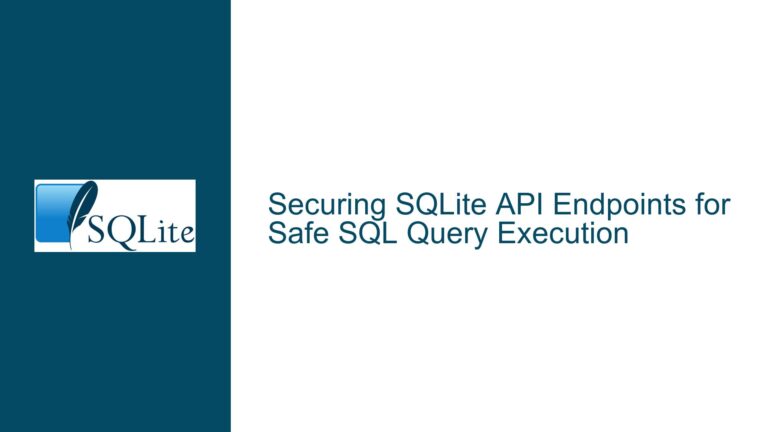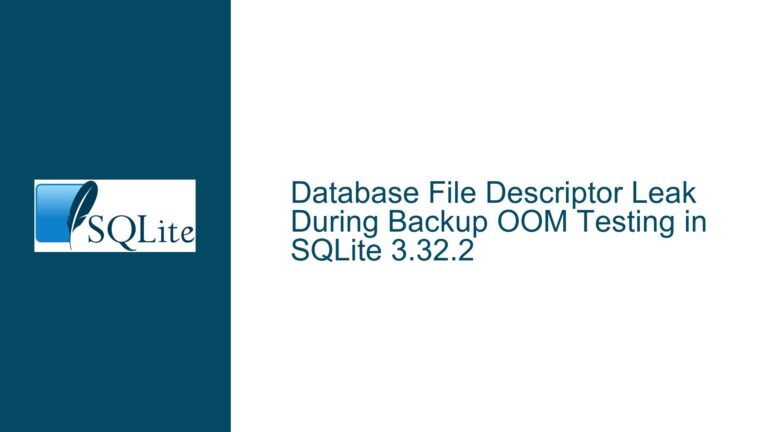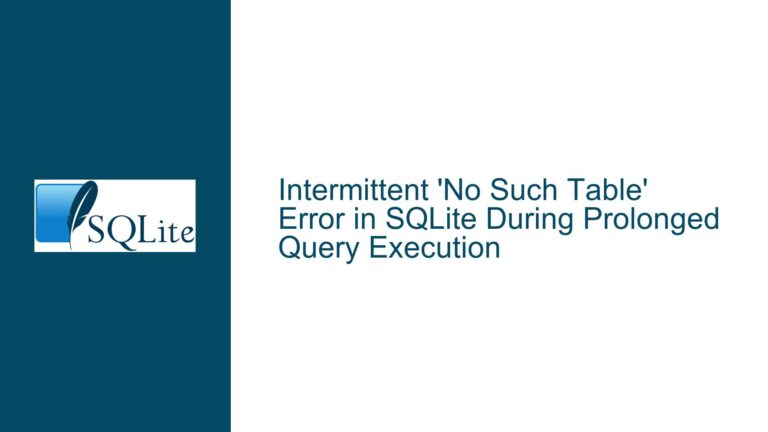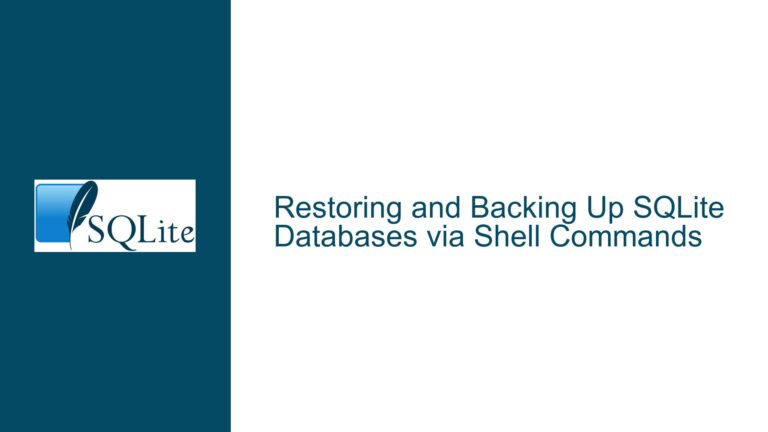Querying the VFS from an SQLite3 Connection: A Comprehensive Guide
Understanding the SQLite3 VFS and Its Query Mechanism
The Virtual File System (VFS) in SQLite3 is a crucial component that abstracts the underlying file system operations, allowing SQLite to operate seamlessly across different platforms and environments. The VFS layer is responsible for handling file operations such as opening, reading, writing, and closing files, as well as other file system-related tasks. Each SQLite3 connection is associated with a specific VFS, which is typically determined at the time the database connection is opened. However, there are scenarios where you might need to query the VFS associated with a given SQLite3 connection handle, either for debugging, optimization, or customization purposes.
The ability to query the VFS from an SQLite3 connection is not immediately obvious, as it involves delving into the SQLite C API and understanding the specific control operations that can be performed on a database connection. The primary function used for this purpose is sqlite3_file_control(), which allows you to send various control operations to the underlying VFS. One such operation is SQLITE_FCNTL_VFS_POINTER, which retrieves a pointer to the VFS object associated with the connection.
Potential Challenges with VFS Querying in SQLite3
While the SQLITE_FCNTL_VFS_POINTER operation is designed to retrieve the VFS pointer, there are potential challenges that developers might face when attempting to use this mechanism. One of the primary concerns is whether this operation is universally supported across all VFS implementations. In particular, custom or simplified VFS implementations, such as those used in testing or specialized environments, might not implement the xFileControl method required to handle the SQLITE_FCNTL_VFS_POINTER operation. This could lead to situations where the operation fails or returns unexpected results.
Another challenge is understanding the exact behavior of the sqlite3_file_control() function when used with SQLITE_FCNTL_VFS_POINTER. The function’s documentation indicates that this operation is one of the special cases handled directly by the SQLite core, rather than by individual VFS implementations. This means that the operation should, in theory, work regardless of the specific VFS in use. However, developers need to be aware of the nuances of how this operation is implemented and how it interacts with the VFS layer.
Step-by-Step Guide to Querying the VFS from an SQLite3 Connection
To query the VFS from an SQLite3 connection, you need to follow a series of steps that involve using the SQLite C API. The process begins with obtaining a valid SQLite3 connection handle, which is typically created using the sqlite3_open() or sqlite3_open_v2() functions. Once you have a connection handle, you can use the sqlite3_file_control() function to send the SQLITE_FCNTL_VFS_POINTER operation to the connection.
The sqlite3_file_control() function takes three parameters: the database connection handle, the name of the database (or NULL for the main database), and the control operation to be performed. In this case, the control operation is SQLITE_FCNTL_VFS_POINTER, which is defined in the SQLite header files. The function also takes a pointer to a sqlite3_vfs object, which will be populated with the VFS pointer if the operation is successful.
Here is a detailed breakdown of the steps involved:
Open a Database Connection: Before you can query the VFS, you need to establish a connection to an SQLite database. This is done using the
sqlite3_open()orsqlite3_open_v2()functions. These functions return a handle to the database connection, which you will use in subsequent steps.Prepare the
sqlite3_file_control()Call: Once you have a valid connection handle, you need to prepare the call tosqlite3_file_control(). This involves specifying the database connection handle, the name of the database (or NULL for the main database), and the control operation (SQLITE_FCNTL_VFS_POINTER).Execute the
sqlite3_file_control()Call: With the parameters prepared, you can now callsqlite3_file_control(). If the operation is successful, the function will returnSQLITE_OK, and thesqlite3_vfspointer will be populated with the VFS associated with the connection.Handle the Result: After the call to
sqlite3_file_control(), you should check the return value to ensure that the operation was successful. If the return value isSQLITE_OK, you can safely use thesqlite3_vfspointer to access the VFS object. If the return value indicates an error, you should handle the error appropriately, which may involve logging the error, retrying the operation, or falling back to a default behavior.Use the VFS Pointer: Once you have the VFS pointer, you can use it to access various properties and methods of the VFS object. This might include querying the VFS name, version, or other attributes, or even invoking methods provided by the VFS implementation.
Close the Database Connection: After you have finished querying the VFS, you should close the database connection using the
sqlite3_close()function. This ensures that any resources associated with the connection are properly released.
Example Code for Querying the VFS
To illustrate the process, here is an example of how you might implement the steps described above in C code:
#include <sqlite3.h>
#include <stdio.h>
int main() {
sqlite3 *db;
sqlite3_vfs *vfs;
int rc;
// Open a database connection
rc = sqlite3_open(":memory:", &db);
if (rc != SQLITE_OK) {
fprintf(stderr, "Cannot open database: %s\n", sqlite3_errmsg(db));
return 1;
}
// Query the VFS
rc = sqlite3_file_control(db, NULL, SQLITE_FCNTL_VFS_POINTER, &vfs);
if (rc == SQLITE_OK) {
printf("VFS name: %s\n", vfs->zName);
} else {
fprintf(stderr, "Failed to query VFS: %s\n", sqlite3_errmsg(db));
}
// Close the database connection
sqlite3_close(db);
return 0;
}
In this example, the program opens an in-memory database, queries the VFS using sqlite3_file_control(), and prints the name of the VFS. If the operation is successful, the VFS name is printed to the console. If the operation fails, an error message is printed instead.
Troubleshooting Common Issues
While the process of querying the VFS from an SQLite3 connection is relatively straightforward, there are several common issues that developers might encounter. Here are some troubleshooting tips to help you resolve these issues:
Ensure the Database Connection is Valid: Before attempting to query the VFS, make sure that the database connection handle is valid. If the connection handle is NULL or invalid, the call to
sqlite3_file_control()will fail.Check the Return Value of
sqlite3_file_control(): Always check the return value ofsqlite3_file_control()to ensure that the operation was successful. If the return value is notSQLITE_OK, you should handle the error appropriately.Verify VFS Implementation: If you are using a custom or simplified VFS implementation, ensure that it supports the
SQLITE_FCNTL_VFS_POINTERoperation. While this operation is handled by the SQLite core, some VFS implementations might not fully support it.Debugging with the SQLite CLI: If you are having trouble querying the VFS in your application, you can use the SQLite Command Line Interface (CLI) to test the operation. The CLI provides a
.vfsinfocommand that can be used to query the VFS associated with a connection. This can help you verify that the operation works as expected in a controlled environment.Review SQLite Documentation: If you encounter unexpected behavior, review the SQLite documentation for
sqlite3_file_control()andSQLITE_FCNTL_VFS_POINTER. The documentation provides detailed information about the function’s behavior and the specific control operations that are supported.Check for Compilation Flags: Some VFS implementations might be conditionally compiled based on certain flags or settings. If you are using a custom build of SQLite, ensure that the necessary flags are set to enable the VFS features you need.
Conclusion
Querying the VFS from an SQLite3 connection is a powerful technique that can be used for debugging, optimization, and customization. By understanding the SQLite C API and the specific control operations available, you can retrieve the VFS pointer associated with a connection and use it to access various properties and methods of the VFS object. While there are potential challenges and pitfalls, following the steps outlined in this guide will help you successfully query the VFS and troubleshoot any issues that arise. Whether you are working with the default VFS or a custom implementation, this knowledge will enable you to gain deeper insights into the behavior of your SQLite database connections.






